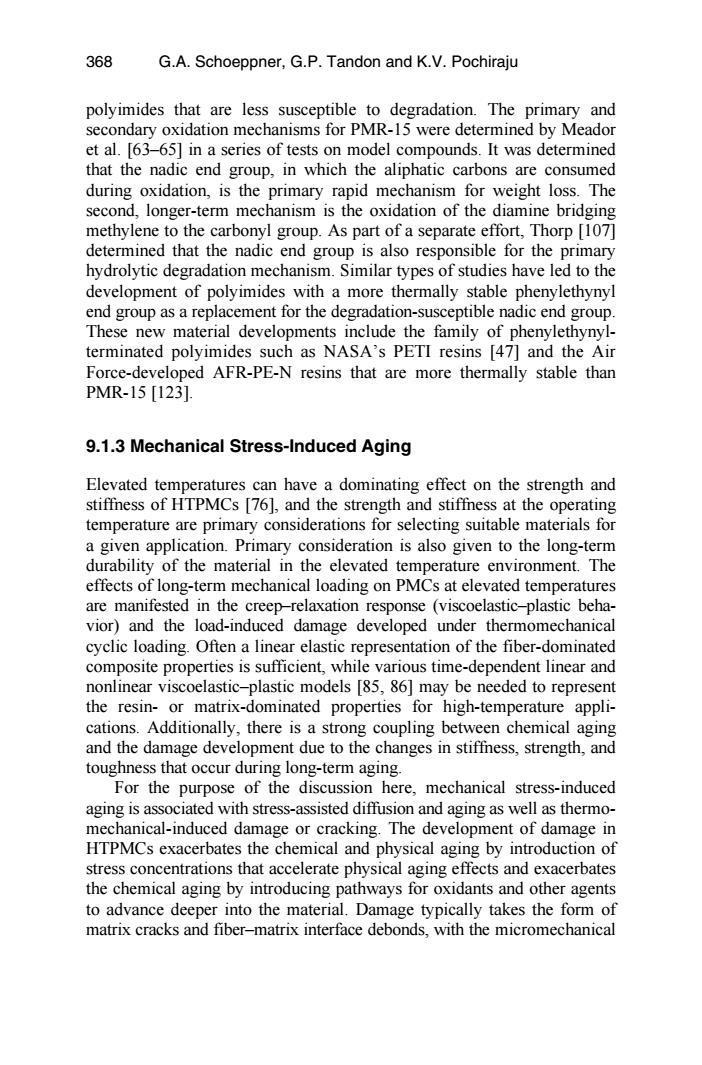正在加载图片...

368 G.A.Schoeppner,G.P.Tandon and K.V.Pochiraju polyimides that are less susceptible to degradation.The primary and secondary oxidation mechanisms for PMR-15 were determined by Meador et al.[63-65]in a series of tests on model compounds.It was determined that the nadic end group,in which the aliphatic carbons are consumed during oxidation,is the primary rapid mechanism for weight loss.The second,longer-term mechanism is the oxidation of the diamine bridging methylene to the carbonyl group.As part of a separate effort,Thorp [107] determined that the nadic end group is also responsible for the primary hydrolytic degradation mechanism.Similar types of studies have led to the development of polyimides with a more thermally stable phenylethynyl end group as a replacement for the degradation-susceptible nadic end group. These new material developments include the family of phenylethynyl- terminated polyimides such as NASA's PETI resins [47]and the Air Force-developed AFR-PE-N resins that are more thermally stable than PMR-15[123]. 9.1.3 Mechanical Stress-Induced Aging Elevated temperatures can have a dominating effect on the strength and stiffness of HTPMCs [76],and the strength and stiffness at the operating temperature are primary considerations for selecting suitable materials for a given application.Primary consideration is also given to the long-term durability of the material in the elevated temperature environment.The effects of long-term mechanical loading on PMCs at elevated temperatures are manifested in the creep-relaxation response (viscoelastic-plastic beha- vior)and the load-induced damage developed under thermomechanical cyclic loading.Often a linear elastic representation of the fiber-dominated composite properties is sufficient,while various time-dependent linear and nonlinear viscoelastic-plastic models [85,86]may be needed to represent the resin-or matrix-dominated properties for high-temperature appli- cations.Additionally,there is a strong coupling between chemical aging and the damage development due to the changes in stiffness,strength,and toughness that occur during long-term aging. For the purpose of the discussion here,mechanical stress-induced aging is associated with stress-assisted diffusion and aging as well as thermo- mechanical-induced damage or cracking.The development of damage in HTPMCs exacerbates the chemical and physical aging by introduction of stress concentrations that accelerate physical aging effects and exacerbates the chemical aging by introducing pathways for oxidants and other agents to advance deeper into the material.Damage typically takes the form of matrix cracks and fiber-matrix interface debonds,with the micromechanicalpolyimides that are less susceptible to degradation. The primary and secondary oxidation mechanisms for PMR-15 were determined by Meador et al. [63–65] in a series of tests on model compounds. It was determined that the nadic end group, in which the aliphatic carbons are consumed during oxidation, is the primary rapid mechanism for weight loss. The second, longer-term mechanism is the oxidation of the diamine bridging methylene to the carbonyl group. As part of a separate effort, Thorp [107] determined that the nadic end group is also responsible for the primary hydrolytic degradation mechanism. Similar types of studies have led to the development of polyimides with a more thermally stable phenylethynyl end group as a replacement for the degradation-susceptible nadic end group. These new material developments include the family of phenylethynylterminated polyimides such as NASA’s PETI resins [47] and the Air Force-developed AFR-PE-N resins that are more thermally stable than PMR-15 [123]. 9.1.3 Mechanical Stress-Induced Aging Elevated temperatures can have a dominating effect on the strength and stiffness of HTPMCs [76], and the strength and stiffness at the operating temperature are primary considerations for selecting suitable materials for a given application. Primary consideration is also given to the long-term durability of the material in the elevated temperature environment. The effects of long-term mechanical loading on PMCs at elevated temperatures are manifested in the creep–relaxation response (viscoelastic–plastic behavior) and the load-induced damage developed under thermomechanical cyclic loading. Often a linear elastic representation of the fiber-dominated composite properties is sufficient, while various time-dependent linear and nonlinear viscoelastic–plastic models [85, 86] may be needed to represent the resin- or matrix-dominated properties for high-temperature applications. Additionally, there is a strong coupling between chemical aging and the damage development due to the changes in stiffness, strength, and toughness that occur during long-term aging. For the purpose of the discussion here, mechanical stress-induced aging is associated with stress-assisted diffusion and aging as well as thermomechanical-induced damage or cracking. The development of damage in HTPMCs exacerbates the chemical and physical aging by introduction of stress concentrations that accelerate physical aging effects and exacerbates the chemical aging by introducing pathways for oxidants and other agents to advance deeper into the material. Damage typically takes the form of matrix cracks and fiber–matrix interface debonds, with the micromechanical 368 G.A. Schoeppner, G.P. Tandon and K.V. Pochiraju